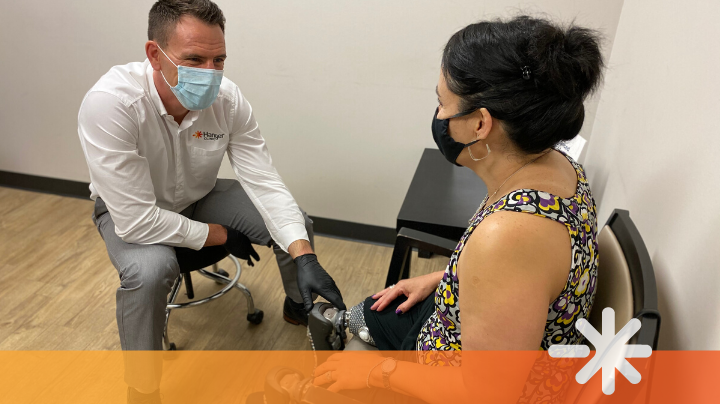Key Takeaways from “The Provision of O&P Care in a COVID-19 World” Webinar

Along with every aspect of the healthcare ecosystem, the O&P profession has faced a significant transformation with the emergence of the COVID-19 crisis, leading providers to adapt to new demands in delivery of care, communication, and increased safety measures.
“The COVID-19 pandemic has forced us to be more collaborative and coordinate our care better than ever before,” Dr. Joseph Webster, National Medical Director for the VA Amputation System of Care said during a May 21 webinar addressing the provision of O&P care during the COVID-19 pandemic.
With over 800 registrants from 45 states and over 250 organizations, attendees consisted of O&P care providers, O&P manufacturers, and healthcare providers, all with the common goal of gaining insights on best practices for providing O&P care during this global pandemic.
Panelists from Hanger Clinic and the VA Amputation System of Care discussed ways in which the pandemic has impacted our communication channels with both patients and referral sources, and how we have had to adapt to new avenues of healthcare provision seemingly overnight. Virtual appointments have become a common care pathway, and there are effective ways to deliver care virtually while addressing inherent safety and privacy concerns.
The panelists discussed different ways O&P providers, in collaboration with the broader healthcare team, can help ensure they are providing care in a safe environment and re-emerging from this crisis stronger and prepared for a new reality.
Developing & Communicating Internal Protocols to Ensure Employee Safety
- The CDC’s guidelines represent an important reference point when developing policies and procedures relating to the safety and well-being of O&P patients and staff during the COVID-19 pandemic.
- The fluid nature of this pandemic and unique nuances of O&P care will inevitably lead to frequent updates of those policies and procedures, so these guidelines should be centralized in such a way that employees can easily access the latest, up-to-date protocol (i.e., web-based document hosting solution, intranet site, etc.).
- Agility and communication are key—you must be prepared to adapt at all times and find communication channels that support this effort.
Minimizing Risk and Ensuring Patient Safety
- As essential healthcare providers, we need to keep our clinics open for in-person visits. However, we should be conducting risk/benefit assessments on an individual basis to determine whether the patient’s need can be appropriately addressed in an alternative manner (i.e., curbside, virtual, etc.).
- An established triage protocol helps minimize risk as it allows us to collect history and develop a treatment plan in advance, leading to shortened appointments and minimized risk for all involved.
- Device handling protocols within the clinic need to be adapted to minimize exposure, allowing for disinfection of the device as well as the surfaces with which it has been in contact.
- Virtual appointments should be embraced as an effective method for delivery of care to minimize the risk of exposure for both the patient and clinician. Clinicians can also complete coding and documentation, collect outcomes data, obtain authorizations, and submit prescriptions with no risk of exposure.
- From an emotional support perspective, peer visits and limb loss support group meetings can also be conducted virtually.
Treating O&P Patients in a Hospital Setting
Dr. Jim Campbell, Chief Clinical Officer for Hanger, said we first need to recognize that not every hospital has the same safety precautions in place, so it is extremely important to contact the facility beforehand to get an understanding of their specific screening protocols. Then, we need to determine if the patient is presumptive COVID-19 positive as well as any associated time sensitivities around the delivery of care, and act accordingly using appropriate PPE.
Re-emergence: Facing a New Reality
Dr. Webster noted that patients requiring O&P services tend to be the high-risk patient population, including the elderly and those with medical comorbidities. We should also be cognizant that anyone with a disabling condition is part of this high-risk population. Even when restrictions begin to loosen for the overall population, the risk for the more vulnerable population may not go down at the same rate, and we should prepare to have ongoing precautions in place to continue to care for this population in the safest manner possible.
A positive outcome of this pandemic is that it has forced us to be more collaborative than ever. As we emerge, we have the opportunity to maintain and strengthen the relationships with the broader healthcare team to facilitate patient care on an ongoing basis, which can ultimately enhance the patient experience and lead to better patient outcomes.
Michael Oros, Regional Vice President for Hanger Clinic in the Midwest, elaborated on the topic: “The demand for services will begin ramping back up as shelter in place and stay at home orders are lifted and may outpace what we are able to do in a normal 8-5 world. Smart/flexible scheduling is key to decreasing volume in the clinic. Resilient organizations will look at these challenges as opportunities and will start to think about these things differently.”
Dr. Campbell concluded the discussion with the inspiring philosophy that Vinit Asar, Chief Executive Officer for Hanger, has instilled company-wide since the moment the pandemic started to take hold in our country: “Be Safe. Be Kind. Be Strong.” He assured us that we are all in this together and that we will emerge on the other side stronger and more united than ever.
Helpful Resources
There were several resources mentioned throughout the course of the webinar, which may help guide organizations as they continue to navigate through this pandemic.
Our COVID-19 Response
Stay up-to-date on the precautions we are taking to provide orthotic and prosthetic care in a safe environment.
Latest Updates
Subscribe to stay up-to-date on our latest posts.


